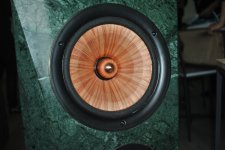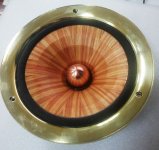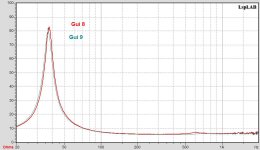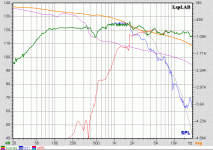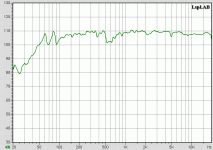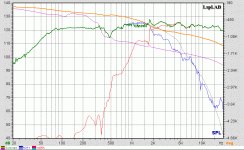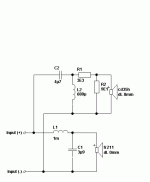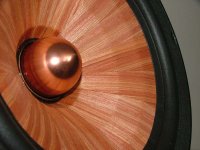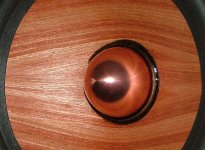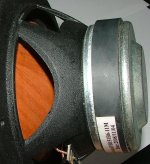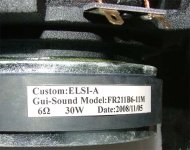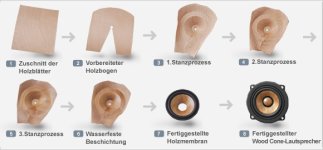For diy'ers I think carbon fiber is not a very good option. Especially vacuum bagging. The first 3 tries, At Least will be lack luster results.
I have used carbon fiber, but I have not vacuum bagged the stuff (dont know why that would be an appealing process honestly) but I have applied it to an easy surface, and, I would say it was not satisfactory. First try with it, I could have done much worse. It is fussy material, especially the generally available weave patterns and weights, its usually the thick stuff that frays very easily, does not conform easily, and wets out very thick.
Cost for mastering the process is too high, results, all in all, meh,
If you want to try something first time with better results, I would suggest not using carbon fiber cloth.
Applying chopped strand carbon fiber, with as much epoxy as you can afford, patting it down, letting it cure and just sanding the randomized carbon flakes flat, then clear coating it....
It would be fairly easy first time with good results, because you wont have to worry about aligning the weave lines just right.
Still looks cool, is strong, but much more realistic and achievable.
How much waste goes into failed attempts because of hopeful and overzealous desire?
I have used carbon fiber, but I have not vacuum bagged the stuff (dont know why that would be an appealing process honestly) but I have applied it to an easy surface, and, I would say it was not satisfactory. First try with it, I could have done much worse. It is fussy material, especially the generally available weave patterns and weights, its usually the thick stuff that frays very easily, does not conform easily, and wets out very thick.
Cost for mastering the process is too high, results, all in all, meh,
If you want to try something first time with better results, I would suggest not using carbon fiber cloth.
Applying chopped strand carbon fiber, with as much epoxy as you can afford, patting it down, letting it cure and just sanding the randomized carbon flakes flat, then clear coating it....
It would be fairly easy first time with good results, because you wont have to worry about aligning the weave lines just right.
Still looks cool, is strong, but much more realistic and achievable.
How much waste goes into failed attempts because of hopeful and overzealous desire?
Also, I think hemp encased in epoxy is gross. It kindof defeats the purpose of having the hemp for beneficial resonance...
For diy'ers I think carbon fiber is not a very good option. Especially vacuum bagging. The first 3 tries, At Least will be lack luster results.
I have used carbon fiber, but I have not vacuum bagged the stuff (dont know why that would be an appealing process honestly) but I have applied it to an easy surface, and, I would say it was not satisfactory. First try with it, I could have done much worse. It is fussy material, especially the generally available weave patterns and weights, its usually the thick stuff that frays very easily, does not conform easily, and wets out very thick.
Cost for mastering the process is too high, results, all in all, meh,
If you want to try something first time with better results, I would suggest not using carbon fiber cloth.
Applying chopped strand carbon fiber, with as much epoxy as you can afford, patting it down, letting it cure and just sanding the randomized carbon flakes flat, then clear coating it....
It would be fairly easy first time with good results, because you wont have to worry about aligning the weave lines just right.
Still looks cool, is strong, but much more realistic and achievable.
How much waste goes into failed attempts because of hopeful and overzealous desire?
Dude...you are digging such a big hole for yourself!
You don't seem to know what you're talking about at all. You clearly didn't know the appropriate application for vacuum infusion, and now you admit you haven't done vacuum bagging at all? How can you give advice to anyone about composites?
But you do it anyway! Rest assured that I will not be following your advice. This is something I have experience in, but clearly you do not. So please stop trying to give advice.
Aww, fredygump sorry you disagree, guess I should defend my argument...
Vacuum bagging is a process that requires special equipment, money, bulk materials, perfect setup, time, and money again when molds and lay ups inevitably have flaws, and repetition. Vacuum bagging will always be more difficult than flat/low complexity flat layups of raw carbon fiber cloth. Why would I try vacuum bagging it when I foresee it not being worth the added cost, not liking the finicky material anyways, greener alternatives, etc, etc, etc.
Diyers are not manufacturing products, they are making things work themselves, So I say, the easier approach is probably the better approach?
Do you think diyers should try and develop fpgas for custom audio interfaces? There are many many layers of complexity, does that make it a good idea? NO! Hahahaha
Carbon fiber weave does not look very appealing on speakers either, aesthetically incompatible with boxy speakers, that's why many manufacturers are not even doing it. Cost and unrealistic application and low feasibility. Carbon fiber bike frame for competition cyclists? Sure, because there is good reason there. Its perfectly lightweight and strong, both things bike frames NEED to be.
Carbon fiber baffles are not the most efficient way to rigidify an enclosure -certainly not with hemp either- so the point you try to make in discrediting my experiences is not completely justified.
2 things I am recommending here, tell me if you have a problem with it...
1 - Polyurethane soaking mdf or composite wood panels for speaker enclosures. Its easy, cheap, and structurally beneficial.
2- Carbon fiber flakes for surface finishing and rigidity. Easy, not costly, no wasted inventory/ extraneous supplies, looks good, very strong, first attempt very likely good results.
Vacuum bagging is a process that requires special equipment, money, bulk materials, perfect setup, time, and money again when molds and lay ups inevitably have flaws, and repetition. Vacuum bagging will always be more difficult than flat/low complexity flat layups of raw carbon fiber cloth. Why would I try vacuum bagging it when I foresee it not being worth the added cost, not liking the finicky material anyways, greener alternatives, etc, etc, etc.
Diyers are not manufacturing products, they are making things work themselves, So I say, the easier approach is probably the better approach?
Do you think diyers should try and develop fpgas for custom audio interfaces? There are many many layers of complexity, does that make it a good idea? NO! Hahahaha
Carbon fiber weave does not look very appealing on speakers either, aesthetically incompatible with boxy speakers, that's why many manufacturers are not even doing it. Cost and unrealistic application and low feasibility. Carbon fiber bike frame for competition cyclists? Sure, because there is good reason there. Its perfectly lightweight and strong, both things bike frames NEED to be.
Carbon fiber baffles are not the most efficient way to rigidify an enclosure -certainly not with hemp either- so the point you try to make in discrediting my experiences is not completely justified.
2 things I am recommending here, tell me if you have a problem with it...
1 - Polyurethane soaking mdf or composite wood panels for speaker enclosures. Its easy, cheap, and structurally beneficial.
2- Carbon fiber flakes for surface finishing and rigidity. Easy, not costly, no wasted inventory/ extraneous supplies, looks good, very strong, first attempt very likely good results.
The carbon fiber speaker is taking shape! I hope to de-mystify carbon fiber a little here, since it works exactly the same as fiberglass!
The process is quite straight forward. I used a 3m 71 adhesive to hold the carbon down to the speaker baffle. Of course it requires some care to avoid disrupting the weave of the carbon, but that isn't difficult.
I was concerned about how to laminate the port exit. I ended up doing the port first in a separate step. I used 4 pieces of carbon, glued them in place and trimmed in place as I installed each one. I just used a knife and cut against the wood. It was a bit fiddly, but the spray glue means it stays once you have it positioned. I also trimmed the outside edges--they extend slightly past the edge of the port flare.
Once cured, the carbon left a defined edge. So when I laminated the baffle, I layed an un-cut piece of carbon over the whole panel, glued it in place, and then used the proud edge of the cured carbon fiber to trim. Once sanded and finished, the transition should be just about invisible.
For laminating the main baffle, the only real "tricks" I used was to use the spray glue to hold the carbon in position, and put a layer of peel ply over the carbon once it was wetted out. The peel ply makes it easier to work out small bubbles and excess resin, without messing up the weave of the fabric. And it makes the carbon fabric lay a little flatter.
At the moment the carbon has a matt finish because of the peel ply, but once it is finished it is going be a gloss finish, and the weave of the fiberglass will really pop. I used 5 harness satin fabric, so it will have a different look than the standard 2x2 twill weave that us usually associated with carbon fiber.








The process is quite straight forward. I used a 3m 71 adhesive to hold the carbon down to the speaker baffle. Of course it requires some care to avoid disrupting the weave of the carbon, but that isn't difficult.
I was concerned about how to laminate the port exit. I ended up doing the port first in a separate step. I used 4 pieces of carbon, glued them in place and trimmed in place as I installed each one. I just used a knife and cut against the wood. It was a bit fiddly, but the spray glue means it stays once you have it positioned. I also trimmed the outside edges--they extend slightly past the edge of the port flare.
Once cured, the carbon left a defined edge. So when I laminated the baffle, I layed an un-cut piece of carbon over the whole panel, glued it in place, and then used the proud edge of the cured carbon fiber to trim. Once sanded and finished, the transition should be just about invisible.
For laminating the main baffle, the only real "tricks" I used was to use the spray glue to hold the carbon in position, and put a layer of peel ply over the carbon once it was wetted out. The peel ply makes it easier to work out small bubbles and excess resin, without messing up the weave of the fabric. And it makes the carbon fabric lay a little flatter.
At the moment the carbon has a matt finish because of the peel ply, but once it is finished it is going be a gloss finish, and the weave of the fiberglass will really pop. I used 5 harness satin fabric, so it will have a different look than the standard 2x2 twill weave that us usually associated with carbon fiber.
Last edited:
Aww, fredygump sorry you disagree, guess I should defend my argument...
Vacuum bagging is a process that requires special equipment, money, bulk materials, perfect setup, time, and money again when molds and lay ups inevitably have flaws, and repetition. Vacuum bagging will always be more difficult than flat/low complexity flat layups of raw carbon fiber cloth. Why would I try vacuum bagging it when I foresee it not being worth the added cost, not liking the finicky material anyways, greener alternatives, etc, etc, etc.
Diyers are not manufacturing products, they are making things work themselves, So I say, the easier approach is probably the better approach?
Do you think diyers should try and develop fpgas for custom audio interfaces? There are many many layers of complexity, does that make it a good idea? NO! Hahahaha
Carbon fiber weave does not look very appealing on speakers either, aesthetically incompatible with boxy speakers, that's why many manufacturers are not even doing it. Cost and unrealistic application and low feasibility. Carbon fiber bike frame for competition cyclists? Sure, because there is good reason there. Its perfectly lightweight and strong, both things bike frames NEED to be.
Carbon fiber baffles are not the most efficient way to rigidify an enclosure -certainly not with hemp either- so the point you try to make in discrediting my experiences is not completely justified.
2 things I am recommending here, tell me if you have a problem with it...
1 - Polyurethane soaking mdf or composite wood panels for speaker enclosures. Its easy, cheap, and structurally beneficial.
2- Carbon fiber flakes for surface finishing and rigidity. Easy, not costly, no wasted inventory/ extraneous supplies, looks good, very strong, first attempt very likely good results.
Yeah, there is no way that a "DIY-er" should think of doing anything remotely interesting! And oviously all DIY-ers have the same skill, exprience, equipment, etc. So it's totally appropriate to appply your limitations to others. I mean, it is impossible for a person who is doing DIY speakers to have [gasp] design, manufacturing or fabrication experience, let alone experience with composites?
And obviously this speaker I'm making is totally ugly. Maybe I can do better next time? Throw it in the bin and start over, right?
Maybe your "forged" carbon fiber is really better? There's nothing about an uneven layer of randomly oriented carbon strands that sounds problematic! LOL! (Seriously people, don't do it. Just don't!)
------
For everyone else, first step of finishing the speaker. I'm coating it with clear resin. Will do several coats to fill in the weave and any gaps in the seams. Sand between coats. It's a little slow, but a simple process. Once I have it built up and sanded flat, I'll coat with urethane clear coat and polish.
I did test out the subwoofer first, because I had a nagging concern that my experimental port design and reduced cabinet volume might not work quite right. But the results are excellent. It rolls off at 20hz, and there is zero port noise or resonance from the speaker. My prototypes had some "noise" when playing a tone. It was noise floor level, and might have just been gaps in the seams, since the prototypes were very quick and dirty (i.e. lazy) construction. At 20hz with this new sub, (20hz is essentially not audible), I mostly just heard cabinet doors rattling. But on other subs, I have started to hear harmonics when playing tones below 30hz. I'm calling it a win!
So yeah, I'm pretty happy with it. Time to start making the second one. But I'm not gonna be done in time to make it to the Parts Express speaker competition this year. Maybe next year?
Last edited:
We seem to have a good counterexample to this statement courtesy fredygump's hard work... The rounding looks great.Carbon fiber weave does not look very appealing on speakers either
Hi, it's Gui-sound company from China made it for my request. they did i for JVC long time ago. I used it offen before. It was 8", 7" and 6"what midwoofers do you use in your marble enclosures?
Attachments
I am ignorant of this term, if I could please ask you to explain.... water break free finish.
http://www.gui-sound.com/e_prd1.asp?pid=2Wood coned? Any 5 dB/div SPL measurements?
Yes, wooden cones. I have it a few model for different resonators. Unfortunately I loose pictures collection after russian missl destroed my house in Hostomel near Kiev 24.02.2023. But to tell the true it's looks better, than sounding.
But measurement looks more better, than visual. This is sealed 20 litres with Fountek NeoCD 3.5H
Attachments
I have always considered sandwich construction to be hugely under-developed as a cabinet material. Stiff and low mass - surely very desirable features. I shall be using 4mm birch ply skins on 20mm Nidaplast core for my next PA speakers.What about balsa wood, skinned inside and out with carbon fibre, to make a light, rigid sandwich, with a layer of mass loaded dampening on the inside? This would mean that the dampening layer would be heavier than the stiffness layer, giving more dampening effect.
Last edited:
Yes, for PA you have to take care about mass, but not for home audio system. More mass - stronger sound 🙂Stiff and low mass - surely very desirable features
find some more pictures into audio discasionroomWood coned?
Attachments
Instead of scoring a surface for gluing adhesion and just sanding for paint application, a more 'methodical' (literal interpretation of our word Tantric 😀)I am ignorant of this term, if I could please ask you to explain.
For working with epoxy and paint for adhesion and finish
Surface is first cleaned up with general sanding then sealed. Wood with Feast Watson or even better a hot PU will do for this and most substrates. Something like Permagloss. Acetone based for etching plus a resin component. This is wet sanded to a glass like finish and hosed with water. Turn off the hose and the water should remain in a skin. The attraction to the surface now is that high that water will break surface tension. This is the surface for best adhesion and paint finishing. Follow the wet sanding and hosing after each primer coat or finish coat
Very true. Also try PVC foam. It may be easier to form rounded corners with that and on parI have always considered sandwich construction to be hugely under-developed as a cabinet material. Stiff and low mass - surely very desirable features. I shall be using 4mm birch ply skins on 20mm Nidaplast core for my next PA speakers.
With the talk about ply skins and natural materials. I am surprised that no one has brought up coconut fibre, This can be used in place of glass for a very nice visual effect. BMW uses this the seats with a rubber resin infusion. Epoxy resin infusion will make a gorgeous speaker with any compound curves over a foam core former
Post your build when you do it. I decided an experimental cabinet material was adding too many unknowns to an already unconventional buildI have always considered sandwich construction to be hugely under-developed as a cabinet material. Stiff and low mass - surely very desirable features. I shall be using 4mm birch ply skins on 20mm Nidaplast core for my next PA speakers.
- Home
- Design & Build
- Construction Tips
- Material Testing: Carbon Fiber Skin on MDF and Plywood
